Shevlin Sebastian's Blog, page 64
November 5, 2017
A Steadfast Faith
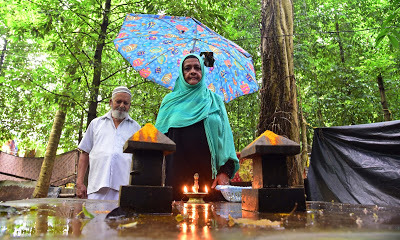 Muslim couple Abu and Asiya Backer, despite protests, continue to worship at the ancestral snake temple at the back of their house in Kerala
Muslim couple Abu and Asiya Backer, despite protests, continue to worship at the ancestral snake temple at the back of their house in KeralaPhoto by Albin Mathew
By Shevlin Sebastian
On the wall of the living room of Abu and Asiya Backer's house at Perumbavur, (41 kms from Kochi) two numbers are written in black: one is of the local police station and the other is the mobile number of the Circle Inspector.
“When people attack us, we get into a panicky mood,” says Asiya, 68. “So, it is easy to dial the number where we can see it.”
It all began in 2013, when an estranged daughter-in-law of their son Mujeeb Rahman, who stays with them, went and complained at the local mosque that her in-laws were praying to Hindu gods.
Indeed, they were and are. The couple has a snake temple at the back. “It has been there from the time of our ancestors,” says Abu, 76. Interestingly, when they go and pray at the site, they say Muslim prayers.
But that is no comfort for the community members. A couple of years ago, a mob of 500 attacked the house, when the elderly couple was away and demolished the structure. Abu and Asiya filed a police case, even as they went about rebuilding the temple.
However, soon after, when Abu went for the Friday prayers at the local mosque, the imam mocked his faith and the way he wore his skull cap. “I stopped going at once,” he says. “It has been a very difficult time.”
On a recent windy and cloudy morning, Abu and Asiya go to the back of the house. They light lamps and place it on a granite top. All around are 30-foot high trees. “When I pray, I can see a light streaming down,” says Asiya. “Only I can see it. So, it is a deeply spiritual experience for me. We will never leave this holy place.”
Asiya says this, despite receiving some tempting offers by affluent locals who said that they would purchase them an apartment. This resistance is all the more remarkable because the family is going through financial difficulties. Mujeeb had taken a bank loan to set up a flour mill near the temple. But because of the disturbances, the mill has closed down. “Now I am struggling to pay off the debt,” says Mujeeb, who runs a taxi service.
For a long time, Abu and Mujeeb did not go to the mosque. But a few months ago, Abu started going again. “By this time, our names had been struck off as members,” he says. “So we don't get any financial benefits. But nobody speaks about the controversy.”Nevertheless, Abu senses a change in attitude. “I believe that people have begun to accept the reasons behind our worship at the temple, although nobody has voiced anything aloud,” he says.
But local municipal councillor Imbichi Koya is not sure. “The people in the area do not have any contact with them,” he says. “It does not mean they have accepted the situation. But there is no harassment now.”
However, Abu says, that their immediate neighbours, who happen to be his close relatives, have not eased up. “Every now and then stones are thrown at the house,” says Abu. “People shout abuse. They want us to leave so that they can demolish the temple. But God has given us the strength to stay firm.”
(Sunday Magazine, The New Indian Express, South India and Delhi)
Published on November 05, 2017 22:18
November 1, 2017
A Joyous Moment. Rare too
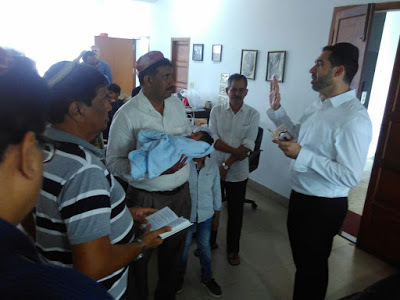 The circumcision of a Jewish baby took place at Kochi after seven-and-a-half years. The community is only twenty strong now
The circumcision of a Jewish baby took place at Kochi after seven-and-a-half years. The community is only twenty strong nowPhoto: Mordokkayi Safir holding his baby son as he listens to prayers said by rabbi Avive Mizrakhi
By Shevlin Sebastian
At 8.30 a.m., last Sunday, around twenty people of the Jewish community gathered at a hall on Marine Drive, Kochi for a ceremony. And it was the rarest one: the circumcision of a baby boy, Menahem Yohan Pallivathukkal. He is the second son of senior marketing professional Mordokkayi Safir and his wife Sarah.
A Jewish rabbi Avive Mizrakhi from Jerusalem officiated as the mohel (the person who performs the circumcision). As Safir, who wore a kippah cap, held Yohan, encased in a blue blanket, in his arms, Avive read out prayers from the Torah.
Following the half-hour ceremony, Safir and Sarah, as well as their relatives, went to the City Hospital. There, following the administration of a numbing cream, the foreskin of Yohan's penis was cut by doctors. It was now that Yohan had officially become a Jew.
This event took place on the eighth day after the birth. “The reason why it is on this day, is because a verse in the Torah commands us to do so,” says Josephai Abraham (Sam), the president of the Association of Kochi Jews. The verse goes like this: 'And on the eighth day, the flesh of his foreskin shall be circumcised'.
Meanwhile, Safir's joy was tempered by the fact that both his parents had passed away a few years ago. “To be frank, I was not keen to go through with the circumcision because of the pain my son would have to undergo,” he says. “But it was Sarah's insistence that Yohan should be a Jew that made me go through with it.”
The couple returned to the hall at Marine Drive. They were greeted with loud claps and cheers. “It is a moment of great happiness when a baby becomes a Jew,” says Sam. “There are so few of us in the city now.” It was at this moment that Safir put a drop of grape wine in Yohan's mouth (this is symbolic of the blood which the Jews shed when they left Egypt and entered Israel after wandering 40 years in the desert).
Meanwhile, drinks flowed and snacks were consumed. Several Hebrew songs were sung loudly. And everybody had a good time.
Interestingly, the last circumcision that took place in Kerala was of Safir's eldest son, Menahim Ryan. “That was seven-and-a-half years ago,” he says, with a smile.
(The New Indian Express, Kerala editions)
Published on November 01, 2017 22:32
The Light At Twilight
 COLUMN: LOCATION DIARY
COLUMN: LOCATION DIARYScriptwriter John Paul talks about his experiences in the films, 'Yaathra', 'Ormakkayi' and 'Adathaduthu'
Photo by Albin Mathew
By Shevlin Sebastian
It was 6.10 p.m. Director Balu Mahendra told Mammooty to get ready for a shoot. This was for the film, 'Yaathra' (1985), which was being shot at a location in Ooty. In the scene, Shobhana (Thulasi) would place some flowers at the base of a Lord Krishna statue. Mammootty's character, Unnikrishnan would come and watch Shobhana do it. This would be the start of an intense romance between Mammootty and Shobhana.
However, Mammootty was apprehensive about the light. So he told the veteran Balu, “Should we take the shot now? The light is fading. Since we will be coming here for the next schedule, we can do it then.”
Balu replied, “We will give it a try. If the shot is not good, we will do it later.”
So, Mammootty did the scene, but with a lack of confidence about the light.
A few days later, Balu called Mammootty to do the dubbing. Scriptwriter John Paul was also there.
“In the scene, the reddish glow of the evening sun reflected the mood within Mammootty's character,” says John Paul. “There were clouds in the sky. And against it, numerous birds were flying. A branch of a tree could be seen hovering at the top of the frame. Meanwhile, drops of perspiration could be seen on Shobhana's face. This highlighted Shobhana's erotic beauty. It was like a Rembrandt painting.”
After the dubbing, Balu said, “Mr Mammooty, how is it? Do we need to reshoot?”
Mammootty immediately said, “I accept. You were right all along.”
Balu smiled and said, “Don't teach your grandfather how to make films.”
While everybody laughed, it was Mammootty who laughed the loudest.
Meanwhile, preparing for his role as a deaf and dumb person in 'Ormakkayi' (1981) was no laughing matter for Bharath Gopi. “He told me he wanted to stay with a deaf and dumb person, in order to understand them better,” says John Paul. So, the scriptwriter arranged for one such person, Suresh (name changed), to spend two days with Gopi at a hotel in Chennai.
But John Paul could not resist a wisecrack to director Bharathan, “There can be only one of two outcomes: either the deaf and dumb person will start speaking or Gopi will become deaf and dumb himself.”
Bharathan burst out laughing.
Anyway, Gopi had a clear agenda. “He was not interested in observing the normal behaviour of Suresh,” says John Paul.
So when Gopi was having a cup of coffee, he purposely dropped the saucer to the floor. “Gopi keenly watched the shocked reaction of Suresh,” says John Paul.
When the thespian went to have a bath, he left the door open so that the man could watch him in the nude. “Again, Suresh had a stunned expression on his face,” says John Paul. “In the film, Gopi incorporated all these expressions.”
Gopi employed the same method for the film, 'Adathaduthu' (1984), where he plays a priest. Again, Gopi wanted to meet a real-life priest. So Paul arranged for him to meet the Kochi-based Fr. Michael Panackal, who was a well-known musician. Gopi asked him how he would bend his fingers when he gave a blessing. The priest showed him.
Thereafter, John Paul, Gopi and Fr. Panackal went for a walk on Banerji Road. While they were walking past a church, the priest half-genuflected and placed his palm over his heart.
“Gopi immediately noticed it,” says John Paul. “And he used this action a few times in the film.”
(The New Indian Express, Kochi, Thiruvananthapuram and Kozhikode)
Published on November 01, 2017 00:27
October 28, 2017
Lessons From Around The World

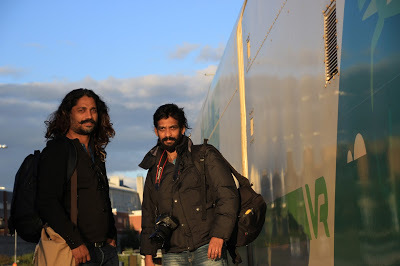
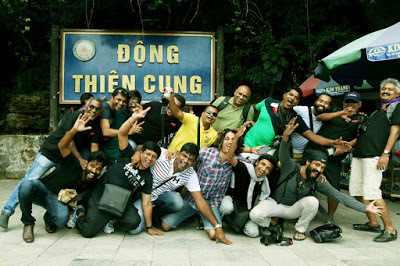 Architects Brijesh Shaijal and Jayakrishnan Karattiyil, founders of the World Architecture Travel group, talk about their experiences
Architects Brijesh Shaijal and Jayakrishnan Karattiyil, founders of the World Architecture Travel group, talk about their experiences
Photos: Paper Island in Copenhagen; architects Brijesh Shaijal and Jayakrishnan Karattiyil; members of the World Architecture Travel group in Vietnam
By Shevlin Sebastian
In Copenhagen, Denmark, there is a place called Paper Island. Here several empty paper godowns have been converted into places where food is served, in separate units. It is located beside a river. “The godowns were in bad shape but it was renovated,” says the Kozhikode-based architect Brijesh Shaijal. “Now it has become a vibrant and popular area.”
Brijesh had gone to Denmark with a group of 30 architects, mostly from Kerala. All of them are part of the World Architecture Travel (WAT) organisation, of which Brijesh is the managing director, while Jayakrishnan Karattiyil is a co-founder.
Whenever the WAT group goes to a country, they would visit the architecturally important places and also interact with the local architects. “These architects would show us their projects on site and explain how the design has been implemented,” said Jayakrishnan. “It is a personalised tour. Then we go to their offices where they show us their recent projects. It is an enlightening experience.”
Sometime ago, one group had gone to New York. While there, they did a walking tour with a local architect. “He explained to us how the development took place, as well as the layering of the city,” says Brijesh. “We began to understand the city from a different angle.”
And an idea has sprung up to do something creative in the Kalai river area near Kozhikode. “There are many old factories,” says Brijesh. “Nowadays, it is not functioning at all. Earlier, the wood used to be transported through the Chaliyar river and came to Kalai. Nowadays it is all transported through trucks. These godowns can be transformed, like the Paper Market.”
In fact, the architects have already made one attempt to make a difference. On Gujarati street, in Kozhikode, there are old houses. They have converted one of them into a space called a Design Ashram. There is a working space, a travellers' hostel, an art gallery and a space for cultural events.
Interestingly, Brijesh finds the architecture styles of Kerala so different from other countries. “The houses in Kerala are made to show off, rather than to fulfill an individual's or a family's need,” he says. “We always think, 'What happens when a guest comes? What do others think about my space or my home?' Even in terms of aesthetics, the house owner wants to make it appealing to the visitor. In Kerala, people have an attitude that you can only be valued when you are able to showcase your house.”
This can lead to a lot of wastefulness. Architect Saumesh Menon (name changed) has built a 20,000 sq ft. house, because the client wanted to impress society, and to get good marriage proposals for his son and daughter. “But years later, when the children get married and move away, there will be too many rooms that will remain closed and dust will gather in it,” says Saumesh.
However, he is hoping that these foreign travels, the last of which was to Vietnam and Cambodia will change mindsets. “We have a few academicians who have come on these trips,” he says. “They will be passing their insights to their students, and who knows this might create a change in our attitude towards houses and buildings.”
As for their future plans, Brijesh and Jaykrishnan are preparing for their next trip. This time it is to Mexico and Cuba and will take place in January 2018. Asked why WAT has chosen these countries, Jayakrishnan says, “Both are vibrant countries with interesting architecture. We thought we would study that and maybe use some of the ideas for our work in Kerala.”
(The New Indian Express, Kochi, Thiruvananthapuram and Kozhikode)
Published on October 28, 2017 02:24
October 25, 2017
A Spoke Through Her Palm

 COLUMN: LOCATION DIARY
COLUMN: LOCATION DIARYActor Shanthi Krishna talks about her experiences in the films, 'Nidhra' and 'Chinna Mul Peria Mul'
By Shevlin Sebastian
In her very first film, 'Nidhra' (1981), actor Shanthi Krishna was standing by the side of a barbed wire fence, at a rubber estate in Pala. In front of her was her screen husband, a mentally-disturbed man called Raju played by Vijay Menon. In the shot, Raju had to run swiftly down a slope. “I was supposed to follow him,” says Shanthi.
But she was only 16 years old and wearing a saree for the first time. So when she ran, she tripped and fell. But in order to cushion her fall, Shanthi reached out and grabbed the fence with her left hand. Unfortunately, a spoke went right through her palm. “Because of the intense pain, the nerves become numb, so, very soon, I could not feel anything,” says Shanthi. “But I could see that my hand was covered in blood.”
Director Bharathan rushed up, along with the other crew members. “They were worried about whether I had fallen on my face,” says Shanthi. Meanwhile, the production controller Gopi covered Shanthi's hand with a towel. Immediately, she was bundled into a vehicle, along with her mother, brother, and Gopi. They rushed to a hospital in Kottayam.
The nurses, on inspecting the hand, said that stitches were needed. Shanthi agreed even though she was scared. “It was a panicky situation,” she says. “When they began work, one nurse held my legs, but I kicked her away. Then, at one place on my hand, I refused to put stitches.”
Meanwhile, Shanthi's mother was crying. “This is my daughter's first film and already, she has been hurt,” she said.
Anyway, after a couple of days, Shanthi returned to the set. But adjustments had to be made. For the climax, when both her hands were needed to be shown, Bharathan used the hands of the producer KJ Joseph's daughter.
Today, Shanthi still bears the scars of that incident. On the back of her left hand, between the forefinger and the thumb, there is a whitish mark, shaped like a tear. On the inside of her palm, across her fore, middle and third fingers, there are stitch marks. “Accidents happen and there is nothing you can do about it,” she says.
This was also the case in the Tamil film, 'Chinna Mul Peria Mul' (1981), which was directed by N S Rajbharath. Shanthi plays a blind girl, whose roommate is murdered by a villain, Anand (played by Raja). However, during the killing, Anand leaves his bracelet behind. So he comes back to collect it. At that moment, Shanthi was walking in her room. Suddenly, her bare feet hits the bracelet and she picks it up. Through the use of Braille, she can read the name, 'Anand' written on it. She knows that Anand will be coming to kill her.
So, she stands against a wall, holding a pair of scissors behind her. Anand enters, locks the door, and approaches Shanthi with a telephone wire. As he tries to strangle her, Shanthi plunges the scissors inside his stomach and runs towards the door.
"The director told me specifically that I should only touch the wooden frame and not the glass," says Shanthi. "But because I was running so fast, even though I held the wooden frame, the momentum resulted in my head hitting the glass and it broke into a shower of small pieces."
Shanthi quickly turned her face to one side, but a piece grazed her left cheek. Not surprisingly, there was a cut. And once again, she was rushed to the hospital. "Thankfully, it was a superficial injury," she says. "But there is still a slight mark on my cheek."
She pauses and says, "Even with the utmost precaution, shooting is still a risky business. Anything can happen at any time."
(The New Indian Express, Kochi, Thiruvananthapuram and Kozhikode)
Published on October 25, 2017 22:35
October 24, 2017
Her Days And Nights
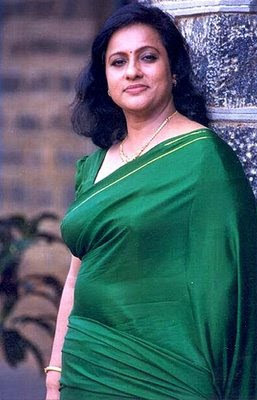 COLUMN: Spouse's Turn
COLUMN: Spouse's Turn
(An interview with Seema in 2013 about her husband, the Mollywood director IV Sasi who died on October 24, at age 69):
Seema talks about life with veteran director I. V. Sasi
By Shevlin Sebastian
One day, in 1977, Seema went to the Vijaya Gardens in Chennai to oversee the shooting of a dance sequence. Seema [original name: Shanthi] and a dancer Manisha had to wait a long time, since shooting had not begun. So they decided to have their tiffin. Suddenly, both of them heard somebody snapping his fingers.
When Seema turned to identify the sound she realised it was the director of the film, IV Sasi. Manisha said, “Why is the director calling us by snapping his fingers? Why can't he use our names?”
Seema remained silent. Then as she was going towards the dustbin to throw away a plastic packet, Sasi said, “Hey, come here.”
Seema said, “Shanthi is my name. I am not a dog that you call me by snapping your fingers.”
“You are a chatterbox,” said Sasi. “There is a dance in my film, ‘Ee Manohara Theeram’. Will you do it?”
Seema said, “I don't want to do a song. I am already acting as a heroine in ‘Nizhalae Nee Sakshi.’”
Sasi did not say anything. The next day, the dance master Vaikom Murthy went to Seema’s house and requested her to dance in Sasi’s film. “I decided to ask for a huge sum of money,” says Seema. “But Sasi agreed. I then asked for more. And again Sasi agreed. I said, ‘Give the money first’. And, amazingly, he sent it.”
So Seema had no option but to dance in the film. And it was after the shoot was completed that Sasi fell in love with her.
In the meantime, Sasi had begun work on ‘Avalude Ravukal’ (Her Nights). Not surprisingly, all the established heroines refused to act in it because the role was that of a prostitute. Sasi did make-up tests and took photo stills of Seema. He liked what he saw, and selected Seema for the role. Of course, it was a path-breaking movie and established Seema as a sexy siren in Malayalam films. By now, both of them were in a relationship.
A couple of years went by. In July, 1980, Seema’s mother, who bought her a diamond, showed it to an astrologer. He said, “It is good that you have bought the diamond now. By September, the girl should get married, otherwise she will have to wait for three years.”
When Seema heard this, she immediately went to Sasi’s house, in Chennai, and said, “If you want to get married to me, it should be before September, otherwise, forget it.” Sasi looked stunned. Then Seema left for the shoot of the film, 'Chaghara', near Thrissur.
A couple of days later, there was a phone call. Sasi told Seema the marriage had been fixed for August 28, at the Mangad temple, near Chennai.
And on schedule the marriage took place. But there was no chance for a honeymoon, as Seema had to return to the shoot.
First love
Cinema was Sasi’s first love or as Seema says, “It was his first wife. I have no problems with that. It was through films that we have earned our bread and butter. So I was happy he was so passionate about it.”
In fact, so intense was Sasi's commitment that when the film’s release day neared, Sasi went through an enormous tension. And, irrespective of whether it was a hit or a flop, the director had severe loose motions for a week. “That will give you an indication of his commitment,” says Seema.
But both were like chalk and cheese. While Sasi never talked, Seema remained loud and voluble. “I think in 37 years we must have spoken to each other for 15 days,” she says.Nevertheless, this taciturn man has been good to his children. Anu and son Ani.
Says Seema, “I am grateful to Sasi Chettan for being with me for so many years and never abandoning me. My husband was a good person and a great director.”
(The New Indian Express, Kochi and Thiruvananthapuram)
Published on October 24, 2017 23:45
October 22, 2017
Fly, Kite, Fly
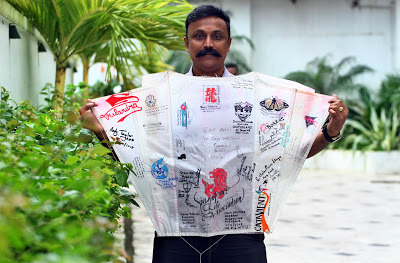
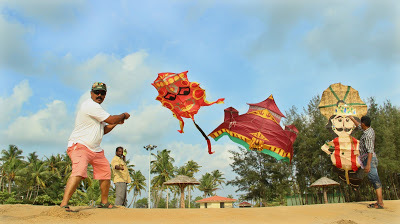 The World Kite, for peace and brotherhood, which is being flown in different countries, has now reached India. The Aluva-based kiter Rajesh Nair has been given the responsibility
The World Kite, for peace and brotherhood, which is being flown in different countries, has now reached India. The Aluva-based kiter Rajesh Nair has been given the responsibilityPhotos: Rajesh Nair with the World kite; with his other kites.
By Shevlin Sebastian
Rajesh Nair has a look of pride as he takes out a kite from his rucksack. It is white in colour. The kite is made of a nylon fabric called ripstop. “It is used in the making of parachutes, and does not tear easily,” says Rajesh. “Ripstop is used extensively in the kiting community.”
Interestingly, the kite has no sticks in it. “This is an inflatable kite,” says Rajesh. “So when there is a wind, you allow the kite to float in the air. On the ground, whoever is holding the string, he can fly it effortlessly, and seamlessly, without any problem, whether there is a light or heavy wind.”
This kite is known as the World Kite. In 2004, Sharon Masto of Canada and Rod Milburn of USA made this 2 ½ feet high kite. “The aim was to spread the qualities of peace, fellowship, friendship and brotherhood,” says Rajesh.
Ever since, the kite has been flown in different countries like the US, Thailand, Australia, Singapore, Japan, Germany and the Netherlands. On the white background, kiters of these countries have put their signatures and drawings.
And now the kite has come to India. This happened when Rajesh went to take part in the 13th Borneo International Kite Festival this month. While there, he met up with long-time participant Andy Taylor from the UK. Andy said, “Rajesh, I am giving the World Kite to you to fly it in India.”
The Aluva-based Rajesh smiles and says, “When Andy gave the kite to me, I felt greatly honoured.”
And he has numerous plans. Immediately, he will be flying it on a beach near Kochi in the presence of many schoolchildren. Thereafter, it will be flown at upcoming kite festivals at Ahmedabad, Puducherry, Panjim and Belgaum. In January, Rajesh is planning to take part in the Dubai International Kite Festival, as well as take part in an event in China.
Meanwhile, Andy had told him that after he had finished flying it in India, he should select another kiter and give it to him. “But he should be a serious kiter and be willing to spread the message,” said Andy.
Since the World Kite has not been flown in China, Rajesh is thinking about giving it to a Chinese kiter. Or it could be somebody from Denmark or Poland, where the kite has also not been flown. After flying in the maximum number of countries the kite will be housed permanently in the World Kite Museum at Long Beach, Washington, USA.
The joys of flying
Not many people know that flying is not an easy thing to do. Since the kite is made of cloth, the wind does not pass through. “Therefore, depending on the wind, the kite could weigh between 150 and 300 kgs in the air,” says Rajesh. “The most comfortable wind speed is 10 to 15 kms per hour.” Surprisingly, on the ground, when the kite is folded, it can be placed inside a suitcase, and weigh only three kilos.
To make the kites, Rajesh works nights and, on the weekends, following his day-job as a consultant on corporate social responsibility for many companies.
Not surprisingly, his enduring love for kites began in his childhood, at Kozhikode. His father taught him how to make his first kite. And, thereafter, his obsession deepened.
“When you fly kites, you experience a sense of freedom,” says Rajesh. “It seems as if I am also flying in the sky along with my kite.”
(The New Indian Express, Kochi, Thiruvananthapuram and Kozhikode)
Published on October 22, 2017 22:19
October 18, 2017
Affection Interrupted
 By Shevlin Sebastian
By Shevlin SebastianShe worked in a bank. I was a college student. One day, after work, I picked her up on my two-wheeler. To get some privacy, I took her to the National Library, where I was a member. It was a tree-filled campus, with few people.
Sangeeta and I started chatting. Feeling affectionate, I placed my arm over her shoulders. We continued to talk. Suddenly, there was the sound of dried leaves being stamped upon. A man, in a khaki uniform, emerged, and told us to follow him. He said, “These things cannot be done in public. I have to take you to the authority.”
I bowed my head and said, “Yes Maam.”
Sangeeta held my hand and said, “You are right.” Did it act as a deterrent? Not at all. We carried on holding hands and I placed my arms over Sangeeta's shoulders whenever I had the opportunity. The friendship lasted for two years. Then, we parted amicably. This mother-of-two now lives in the United States. Looking back, in ripe middle age, the question remains: In the land of Kama Sutra, why do we remain such prudes?
(Published as a middle in The New Indian Express, South Indian editions)
Published on October 18, 2017 22:57
October 17, 2017
Highlighting A Legend's Life
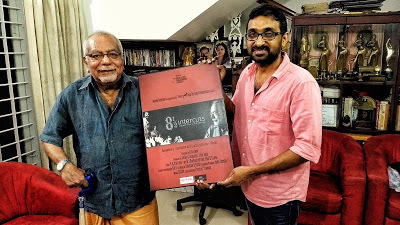
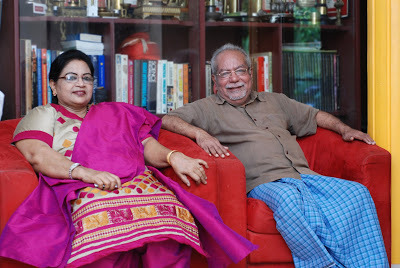 Director Lijin Jose talks about '8 ½ Intercuts – Life and Times of KG George', which was screened recently in Kochi
Director Lijin Jose talks about '8 ½ Intercuts – Life and Times of KG George', which was screened recently in KochiPhotos: KG George (left) with director Lijin Jose. KG George with wife Selma. Photo of the couple by Manu R Mavelil
By Shevlin Sebastian
About half-way into the documentary, '8½ Intercuts – Life and Films of KG George', which was shown recently at the SIGNS Festival, at Kochi, the camera focuses on George's wife, Selma who sitting next to the director. And that is when she says: “My husband was involved with other women and that hurt me a lot. But whatever he did, he would come home and tell me. How painful it was. I would go on crying. He said he was telling me this so that I would not hear about this from another source. However, this is something that no woman can tolerate.”
For director Lijin Jose and the crew, this was a stunning moment. “We could not believe that Selma Maam was saying all this on camera,” says Lijin. “But what I found most interesting was the reaction of George Sir. He had no anger or frustration about what she was saying. Instead, he had a small smile and looked innocent. It was admirable that he had given Selma the space to react like that.”
In fact, spending time with George enabled Lijin to get a better insight into his character. “George Sir is a transparent person,” he says. “He also had no self-doubts, whether it was regarding his films, his religious or political beliefs.”
This is clear when you watch '8 1'2 Intercuts', which is an engaging and well-made documentary. It focuses on George's life, his humble beginnings, at Tiruvalla, and as he grows older, his growing passion for cinema, the stint in the Film and Television Institute of India, his marriage, and how he went about fulfilling his dream of making meaningful cinema. All this is narrated by the 71-year-old director himself, The documentary focuses on nine films. These include 'Yavanika', 'Lekhayude Maranam Oru Flashback', 'Mattoral', and 'Adaminte Vaariyellu'.
It is a given that Lijin is a die-hard fan. “George Sir cannot be compared to other directors,” he says. “He made stunning social commentary, as well as psychological portraits, and all this was done without any exaggeration. He was active from 1975 to the early 1990s and helped us to understand what Kerala society was like in those times.”
It has resulted in an oeuvre that was bold, daring and visionary. Therefore, it is no surprise that many celebrities spoke admiringly about his work. They included actors like Mammootty, Innocent, Nedumudi Venu and Fahadh Faazil, writers like MT Vasudevan Nair and the late ONV Kurup, directors like Adoor Gopalakrishnan, Lijo Jose and the late Balu Mahendra, scriptwriter John Paul, film editor Beena Paul as well as technicians who worked with the director.
Apart from them, there are many ordinary cine-goers who remain die-hard fans. “When people heard that I was making a film on George Sir, they would ring up and ask for updates,” says Lijin. “But I also wanted to make the film for the younger generation who have not heard about him.”
Lijin, who has made two Mollywood films, 'Friday' and 'Law Point', got the idea to do the film from his friend, the writer Shahina K. Rafiq, who was doing her doctorate in films. When he approached George, he was amenable, because he had seen 'Friday' and liked it. Shooting began in March 2013, but it took four years to finish. “What took time was to get the many celebrities to speak on camera,” says Lijin.
Among the people who helped Lijin were editor B. Ajithkumar, music director Bijipal, as well as camerapersons MJ Radhakrishnan and Neil D' Cunha. Funding was provided by producer Shibu G Suseelan as well as the Kerala Chalachithra Academy. The film cost Rs 8 lakh to make. “We do not expect to recoup the money,” says Lijin. “It is a labour of love.”
(The New Indian Express, Kochi and Thiruvananthapuram)
Published on October 17, 2017 01:11
October 13, 2017
Young and Bright
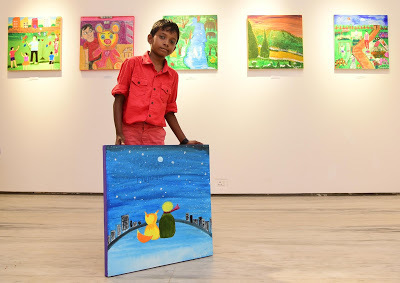
 Prayagh Sanjeev Krishna, at just age nine, has held a solo exhibition
Prayagh Sanjeev Krishna, at just age nine, has held a solo exhibitionPhotos by Albin Mathew
By Shevlin Sebastian
At the Durbar Hall, Kochi, recently, a boy was running around the halls of the art gallery. He was of slight build, with an innocent cum mischievous look. So, it comes as a surprise when artist Bindhi Rajagopal says, “He is having his own show.”
Yes, Prayagh Sanjeev Krishna, who is only nine years old, is having a full-fledged exhibition, with 28 of his works on display.
The majority are acrylic on canvases, while the rest are crayon drawings. One such crayon drawing is of a boy standing next to a teddy bear. “Prayagh had drawn this for an inter-school competition and was awarded the third prize,” says Bindhu, Prayagh's mother.
Most of the works are of nature and animals. There is a black and yellow butterfly against a bright and colourful backdrop of numerous flowers. Another one is of a river between high hills. Then, there is a cat looking with enlarged eyes at an aquarium full of fishes.
A few are from his own life. There is one acrylic work of a scene in a park. It is a simple work of a yellow sun against an azure sky, and lots of black birds flying around. Down below, just beside a mud path, a man is standing. He is dressed in a pink shirt and red trousers. “That is my father,” says Prayagh. On a swing sits a small boy, while on a slide, a bigger boy is lying down. “I am on the swing, while my elder brother is on the slide,” he says. A young girl in a blouse and paavada is sweeping the leaves off the grass. There are several flower bushes all around. “The girl is my neighbour,” he says.
Another work is a night scene. The sky is full of stars and sitting on a mound is a boy with a cat next to him. Prayagh has drawn them from the back. “This is also my neighbour Nihad and his cat,” he says.
Prayagh's interest in painting was inspired by his elder brother, Pranav, who is ten years older than him. Pranav would take part in art competitions in school. And Prayagh, from age three onwards, would tag along. Just to keep the toddler quiet, Pranav would give him a piece of paper along with some crayons. Then he would do some drawings. And the habit continued.
Today, as a student of the Mar Thoma Public School, at Kakkanad, Prayagh gets lots of support and encouragement from his art class teachers, Thomas and Shirley.
And he is a boy on a ceaseless creative flow. “Prayagh does his paintings in the evenings when he returns from school,” says Bindhu. “Sometimes, when he is playing outside, with his friends, he will get inspired and rush home and start drawing. On other days, when he gets up in the morning, he will get an idea and immediately do a work.”
Artistic talent runs in the family. Prayagh's father Sanjeev K is a Carnatic vocalist who teaches children in a freelance manner. On the other hand, Bindhu is a vocal trainer at the Mar Thoma school. Pranav is learning animation design. The family have a troupe and they go all over Kerala giving performances. “Prayagh can also sing very well,” says Bindhu.
The family will offer full support as Prayagh grows older. “We might enrol him in an art school,” says Sanjeev. Adds Bindhi, “By holding an exhibition, Prayagh is already an artist. He has a bright future.”
Already making a mark
Winner of All India Clint Memorial AwardBalarama Odissia State winnerBalarama YMCA State winnerHas won Kerala Fine Arts Society Award five timesHas won Fresco Best Artist Award three timesFACT All Kerala Competition winner five times.
(The New Indian Express, Kochi and Thiruvananthapuram)
Published on October 13, 2017 00:29



